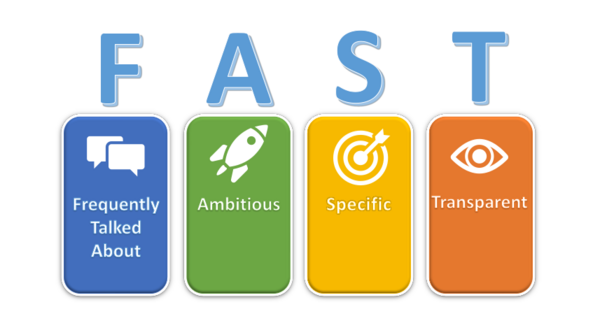FAST Goals
Created by Frederik Mørup Carlsson, 2021
Creating a plan is pivotal for the success of any project and the management of said project[1]. Key to any plan is goals: Objectives, milestones, or deliverables[1]. Whatever shape the goal takes, without goals a plan is imperfect. Correct utilization of goals is therefore critical for project and project management success. Setting the wrong goals will waste valuable resources[1], setting the goals too low will result in lower quality outcomes [2]and failure to communicate the goals adequately will leave those within the project without direction[3]. Ensuring high quality of the goals and correct utilization within the project is therefore a skill that project managers must master to save time and resources. FAST goals is a framework created to help practitioners setting and managing goals by ensuring the quality and proper usage of their goals through the acronym 'FAST': Frequently talked about, Ambitious, Specific, and Transparent[4] .
FAST goals strays from more traditional goal setting methods such as SMART goals, and proposes itself as a reorientation to the way practitioners approach goals[4]. Based on research and industry success the FAST goals attempt to summarize how goals as a whole should be approached and utilized, modernizing goal setting through the inclusion of more agile practices and a focus on the surrounding environment [4]. This article will further explain the meaning and qualities of each of the four letters in FAST, compare it to the similar methodology of SMART goals, as well as exploring the limitations of the FAST goals within project management. This article aims to provide information on the strengths and limitations of the FAST goals, how and when to apply them so that project managers can extract the most value of the methodology.
Contents |
Effective goal setting that enhances strategic alignment
In the PMBOK guide, the purpose of a project is defined as such "Projects are undertaken to fulfill objectives by producing deliverables." [1]
Intrinsically linked to the purpose of the project, the reasoning for why it has been undertaken is the project objective. A project is not a project without something that it tries to achieve. The overarching goal of the project is one of many smaller goals which combine to be the project plan. Depending on the complexity of the project these goals can be divided further over and over again until the goals reach a manageable size. Goals permeate the very nature of projects with entire management styles revolving around the creation and execution of goals [5].
The importance of goals within project management is therefore critical. Not only are goals abundant in project management, but correct utilization of goals can also bring benefits such as higher motivation [2], higher performance, and work satisfaction[6], etc. Poor utilization of goals negatively influence the planning, poor planning then is associated less chance of success of reaching goals [5]pp. 69, waste of resource, reduction in quality and frustration [7] .
It should therefore come naturally to all project managers to strive for setting goals of high quality. However, what is a goal of high quality? The PRINCE2 project management guide suggests that project objectives should adhere to the SMART (Specific, Measurable, Achievable, Relevant, and Time-bound) goals framework [7]. The SMART goals framework dates back to 1981 [8], and depending on the source each letter of the acronym can take a new meaning. Some even suggest an updated version of the acronym to SMARTER (Specific, Measurable, Achievable, Relevant, Time-bound, Efficacy, Rewarding) [9], again the newly included latter two letters take on new meaning dependent on the source. According to the PRINCE2 guide a SMART goal is a high-quality goal, yet there exist management practices that diverge from SMART in favor of other ways to set high-quality goals.
One such practice is the OKR (Objectives – Key Results) methodology. It proposes a vastly different approach to goals compared to SMART goals. In the OKR methodology, objectives are set up with a set of key results attached. The act of the goal-setting in the OKR methodology is reminiscent of how goals are set using SMART goals however, the emphasis in the OKR methodology is split between the initial creation of OKRs, feedback and revision, strategic alignment, and transparency [3]. The OKR methodology embraces adaptiveness by focusing not only on goal setting but including surrounding factors to ensure the goals stay relevant and correctly prioritized throughout the project. This is a particularly important thing that is built into the OKR methodology which is not in SMART. As such the OKR methodology does not seek only to answer the question, what is a high-quality goal? It attempts to give a methodology that serves as a way to both set high-quality goals and be high-performing when executing those goals.
In 2018 an article called: With Goals, FAST Beats SMART was published as part of a series of articles dubbed The Strategic Agility Project. The Strategic Agility Project series of articles aims to help practitioners find better alignment between strategy and goals within organizations [10]. In this article the sentiment of the OKR methodology is echoed, to construct goals that align with strategy, it is not enough to set goals of high quality. Donald Sull and Charles Sull describe how generally people have become too focused on the act of setting goals, and not enough attention is being given to how goals are used. Proposed in this article is the 'FAST': (Frequently talked about, Ambitious, Specific and Transparent) goals, a new goal methodology with the aim of reorienting how goals are perceived and worked with. It is proposed that through utilizing the FAST goals framework the way goals are utilized can be reframed to bring about goals that increase motivation, produce higher quality outcomes, and better aligns with the overall strategy. The purpose of the FAST goals is thusly aiding in both the setting of high-quality goals and facilitating the environment surrounding the goals, which allows for high-performance utilizing the goals, executing on what is strategically important, and improving the work environment [4].
So far the FAST goals have been described as conceived with organizations in mind, however, this article will frame the FAST goals in a project-oriented context, and focus on the application and benefits of using this tool in projects.
FAST goals
If the above section served to answer the question, why should you care about the FAST goals, the following section aims to answer the following: What exactly are the FAST goals, and how can using this tool benefit me?
As mentioned earlier the sentiment of the pioneers of the FAST goals is that there is a wrongful one-track focus on goal setting for practitioners. The FAST goals then try to widen the scope of what goal setting is through including a focus on surrounding culture and agility in order to bring additional benefits [4]. The FAST goals, however, are not a readymade template that can be plugged into any project and be expected to work, they are instead a set of tenants which if adhered to and properly applied within a project can bring tremendous benefits. These tenants are the four letters that make up the acronym FAST. Frequently talked about, Ambitious, Specific, and Transparent. A figure depicting these alongside the acronym FAST is included for a visual overview. Each of the tenants will be described in detail in the following sections and points of note will be highlighted. Accompanying these sections will be a figure which depicts the definition and recaps a list of benefits derived from the correct utilization of each tenant by the authors of the FAST goals. These are intended as a means to quickly introduce or refamiliarize the tenants of the FAST goals.
Frequently talked about
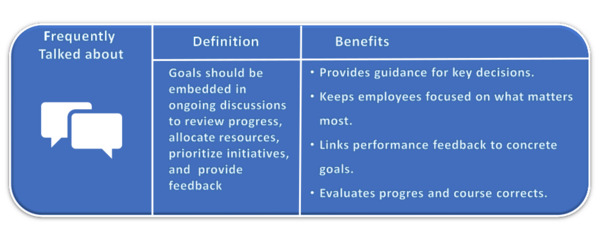
The first of the four tenants of FAST is F, for Frequently talked about. The definition of Frequently talked about coined by D. Sull and C. Sull is:
"Goals should be embedded in ongoing discussions to review progress, allocate resources, prioritize initiatives, and provide feedback. "[4]
Two particular things in this definition are important. The first of which is the word frequent. For many, the standard practice is to set goals and forget about them for upwards of a year before reviewing them [4]. To make goals FAST it is a necessity to frequently review your goals. Frequent is up to interpretation, however the FAST goals advocates for normalizing discussion, reflection, and revision of goals [4]. The second thing of importance in the definition is that what frequently needs to be discussed is not merely progress. Instead, it is several factors that relate to the goal. The focus on feedback, resource allocation, and prioritization shift the focus from the one-track approach of setting a goal and measuring whether or not it is reached [4]. A FAST goal is therefore not the same from its conception to its end, it can adapt and change as the environment around it does. FAST goals take the typically predictive approach to goal setting and change it to be a more adaptive approach.
Frequently talking about goals is one of the ways FAST goals draw inspiration from OKR methodology, and while the FAST goals are a new and mostly undocumented methodology the benefits that frequent discussion surrounding goals can have can be extrapolated from the OKR methodology. In John Doerr’s book “Measure What Matters”, he describes the OKR methodology as having four superpowers, three of which are derived in some way from the frequent conversation around goals [3]. These three superpowers are Focus and commitment to priorities, alignment, and connectivity for teamwork, and the ability to track for accountability [3]. Frequently talking about goals enables these superpowers in ways such as ensuring goals fit with priorities, talking about goals allows for revision which then provides focus, it enhances teamwork through a reduction of uncertainty across teams.
Ambitious
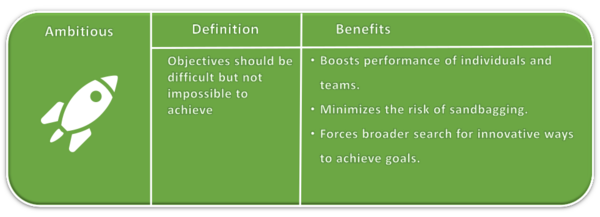
The second tenant of FAST, defined as:
"Objectives should be difficult but not impossible to achieve"[4].
The definition of this tenant is straightforward, but extreme importance should be paid to the latter half. While benefits can be achieved from setting ambitious goals, the reverse can be seen if goals are infeasible to achieve as will be elaborated upon later. The challenge for project managers then becomes to create goals that are ambitious enough, yet not as much as to be impossible.
As for benefits several studies link ambitious goal setting to employee motivation [6] [2] [4], the PMBOK guide even puts one of the project managers' responsibilities in terms of managing teams to be providing challenging goals [11]. The same study which linked ambitious goals to motivation also links ambitious goals to high performance.[6]. The benefits of setting ambitious goals is therefore straightforward. This is further exemplified in the book Measure What Matters where John Doerr establishes the importance of setting ambitious goals in order to perform higher [3]pp. 184. With ambitious goals comes the risk of not meeting goals. To facilitate aiming high and creating ambitious goals, it must be accepted not to reach them. With what has been presented it might seem fitting to create goals that are ambitious to the point of impossibility, however, the reverse effect of ambitious goals, lack of motivation, and low performance, has been linked to impossible goals[2] [4].
Specific
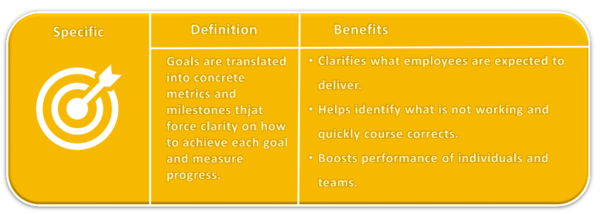
The third tenant of FAST, Specific, is defined as:
“Goals are translated into concrete metrics and milestones that force clarity on how to achieve each goal and measure progress.”[4].
The reasoning for this tenant might be considered common knowledge, as it is a constant throughout many goal-oriented methodologies, and the definition is quite straightforward. Both the PMBOK guide and PRINCE2 references the need for specificity in planning and in general throughout project management "[1] [4]. Other methodologies different from FAST and SMART include the need for specificity and measurability as a requirement for goal setting [3]pp. 46[12]. [5] It is never the less of vital importance to ensure due diligence when it comes to this tenant, as it is one of the core components of the actual goal setting.
As for benefits creating specific goals specific goals are linked to increased motivation and performance [2] [4] [3], clarity around objectives [4] [3], and linking goals to strategy [4] [3].
Transparent
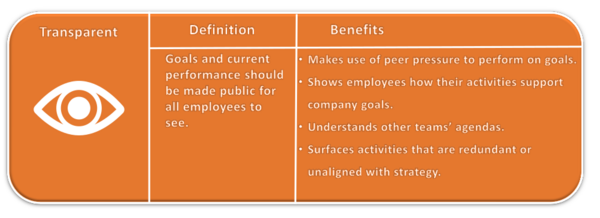
The final tenant of FAST, Transparent, is defined as:
"Goals and current performance should be made public for all employees to see."[4]
The important part about the definition is recognizing that creating transparent goals is not about understanding the goal or the meaning behind it, it is instead how it is treated which has to be transparent. The definition is rather straightforward in what it is saying, it can however be difficult to understand. What FAST goals advocate for is enabling everyone within a project, from the project manager and through the rest of the project, to see the goals of everyone else within the project. In a study done by the authors of the FAST goals, a mere 25% of managers answered that the goals they had set were understood by fellow managers within an organization [4]. This can lead to frictions such as improper focus, wasting resources on duplicate work, and poor cross-team communication [4] [3]pp. 59
The benefits of doing transparency right is linked to things such as better strategic alignment, improved motivation, and becoming more attractive to high-performing workers. [13] [14].
Comparison to SMART goals
Despite their apparent similarities of the two methodologies, FAST goals separate themselves rather drastically from SMART goals. While the SMART goals serve as a checklist of things to keep in mind when creating goals, FAST goals focus both on goal setting and on creating a better surrounding environment for goals. Noticeably SMART and FAST share many similarities such as both emphasizing specificity. Furthermore as was discussed in the section about ambition, attainability is still key to extracting the benefits of ambition, too much of either leads to worse results. The reason why FAST goals focus on ambition over attainability is historically ambition has been neglected within goal setting[4].
In terms of goal setting FAST goals reprioritizes what is important, but do not stray far from SMART goals. The real difference between the two methodologies comes from the more agile approach of FAST goals and the splitting of the focus from goal setting to both goal setting and goal utilization. FAST goals should therefore not be thought of as a direct replacement to SMART goals, FAST goals are not just four new letters to remember which are more important than those in SMART. Instead, FAST goals should be thought of as a new perspective, a new approach to goals within projects. There are drastic changes needed for a project to have FAST goals as opposed to SMART goals, but for many, this approach has proved tremendously successful [4].
Application
As a rather new methodology, appearing first in 2018, very little evidence is publically available to chronicle the application of the FAST goals. The authors of the FAST goals however highlight the methodology of OKR (Objectives - Key Results) as being in accordance with the FAST goals. To describe the application of FAST goals much of the basis will be taken in the application of the parts of OKR methodology which relate to the FAST goals. For a better understanding of what OKRs are I suggest the book Measure What Matters by John Doerr of which much of this section will be based on. To begin explaining the application of FAST goals through the application of OKRs the following quote from the aforementioned book gives perspective.
OKRs have such enormous potential because they are so adaptable. There is no dogma, no one right way to use them. Different organizations have fluctuating needs at various phases of their life cycle. For some, the simple act of making goals open and transparent is a big leap forward. For others, a quarterly planning cadence will change the game. It’s up to you to find your points of emphasis and to make the tool your own. [3]
The unfortunate reality is that there is no one right way to do it, no one size fits all solution. In an interview with John Doerr, he emphasizes that the OKR methodology is not a silver bullet that guarantees success. He describes how without the fundamentals of a good culture and skilled management the value of OKRs is diminished [15]. In order to apply either the FAST goals, it is therefore imperative that practitioners remain acutely aware of the fundamentals of project management. Without those, there is no guarantee that the sought-after benefits from utilizing this tool will be realized. Understanding the four tenants of the FAST goals, what it is they each try to achieve, and tailoring these to your project is a prerequisite for unleashing the benefits of the framework. There is therefore no guide on how to apply OKRs or FAST goals to all projects.
The following is based on a test designed by the authors of the FAST goals to determine whether or not your goals adhere to the FAST goals framework [4]. If you can answer yes to the above questions your goal setting methods are aligned with the FAST goals framework. If you can not answer yes to some, it is up to the project manager to determine how to structure the necessary changes to change that no to a yes.
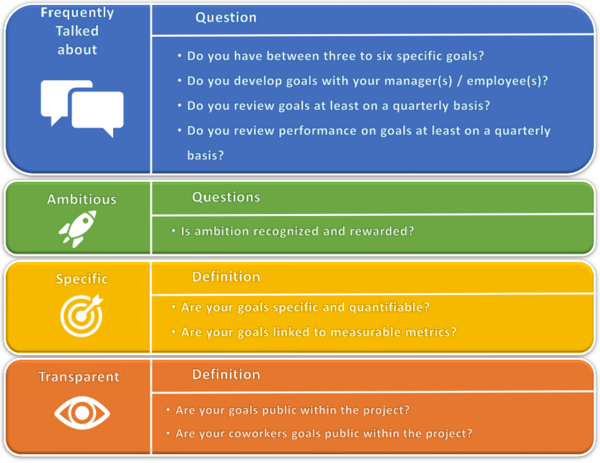
It should also be noted that being able to answer yes to the above questions is not a guarantee that your goal setting is optimal for your project. Understanding what each question attempts to test and understanding the relation to the four tenants of FAST and their benefits, will allow you to better compare on your project whether or not you are adhering to FAST principles and realizing the intended benefits. While it has been determined that it is impossible to provide a template for every project on how to establish FAST goals in any project, the following will be some examples of how to initialize the implementation which has proved to work in a variety of cases when applying OKR methodology.
- Ease into the process
For many applying FAST goal methodology will be a disruptive change to the status quo. It is, therefore, advisable to ease into the process. For this applying the methodology at the top and working downwards has shown to be effective. [3]
- Ensure that goals are made public
Many benefits are reliant on the goals being public and that everyone at any time has easy access to goals, not just their own goals but also others, especially strategic goals. Exerting the effort to make goals public is therefore a good place to start to apply the FAST goals.[3]
- Frequent check-ins
Frequently checking in on progress allows for goals to be changed to reorient, or be abandoned before resources are wasted. Engaging this change is therefore critical to enable the FAST goals methodology to function. [3]
- Initiate a culture change
To be transparent, open in your frequent discussions, and ambitious in your goals, it might be necessary to undergo a culture change. It has been shown to be effective to have top management set a good example for this, and set the standard throughout the project. .[3]
Applying the FAST goals to your project is not as easy as handing out a guidebook and following the steps. It can be a fundamental change to how your projects embrace goals and working with them throughout your project, and the way to do it varies from project to project. It is therefore a challenge for the project manager to identify which parts of the FAST goals are most important for the project, and what changes are necessary to enable them in order to apply the methodology.
Limitations
The FAST goals have been created with the modern-day in mind [4], and where many projects and organizations have become far more adaptive to change there are still sectors where attempting to apply the FAST goals would simply be an addition of costs with little benefit. Furthermore, the FAST goals are a new methodology, and extensive research has yet to be given to them. Little research has been done on the application or the realization of the benefits from FAST, it might be difficult or risky to attempt to apply this methodology. Furthermore the FAST goals themselves, ironically enough, is quite unspecific. It might be easy to get lost without a more specific guide for application. The correct way to enable transparency and frequently talking about goals is different from project to project, and it, therefore, relies on the project manager to adapt these tenants of the FAST goals to the individual project. This is a limitation for newcomers with little reference material to attempt to learn or adapt from. As mentioned earlier in regards to OKRs, John Doerr describes OKRs as heavily reliant on fundamentals [15]. Utilizing FAST goals will not solve any and all issues and might be a detriment without a proper fundamental base to grow from.
Annotated bibliography
With Goals, FAST Beats SMART - The article introducing FAST goals. This is the maiden work related to the FAST goals, introducing the reasoning behind the creation of the methodology, the research which led to the FAST goals as well as the meaning behind each of the four letters of the acronym in great detail. Additionally, this article presents the FAST goals as superior to the SMART goals, seeing it as an evolution of the concept of SMART goals more fit for modern-day project management. This article includes many real-life examples of aspects of the FAST goals in practice in high-performing companies.
John Doerr on OKRs and Measuring What Matters - A sub-30-minute video interview between one of the authors of the FAST goals, Donald Sull, and the author of the book Measure What Matters, John Doerr. In this interview, OKRs are broadly introduced as are the benefits of utilizing them. John Doerr provides great insight into the methodology and manages to provide a great understanding throughout the interview. This interview provides a great entry point for those who want to know more about OKRs and the theory behind them. Furthermore, John Doerr shows his great experience within management and management with OKRs to provide many great insights into why he supports this methodology.
Measure What Matters - A book describing the OKR methodology which goes into great detail talking about benefits, real-life success stories, and more. It serves as a broad introduction to the methodology, which also provides a lot of background on how it came to be. Seeing as FAST goals are quite related to the OKR methodology this is a great entry point for any interest in one or both of the two. It also provides interesting real-life experiences and insight from some of the biggest companies like Google.
References
- ↑ 1.0 1.1 1.2 1.3 1.4 "Project Management Institute, 2017, A guide to the project management body of knowledge (PMBOK guide), Sixth edition, Project Management Institute, Inc."
- ↑ 2.0 2.1 2.2 2.3 2.4 "Lunenburg, F, 2011, Goal-Setting Theory of Motivation, International Journal of Management, Business, and Administration., vol. 15, no. 1, pp. 1-6."
- ↑ 3.00 3.01 3.02 3.03 3.04 3.05 3.06 3.07 3.08 3.09 3.10 3.11 3.12 3.13 3.14 "Doerr, J, 2018, Measure What Matters, Penguin."
- ↑ 4.00 4.01 4.02 4.03 4.04 4.05 4.06 4.07 4.08 4.09 4.10 4.11 4.12 4.13 4.14 4.15 4.16 4.17 4.18 4.19 4.20 4.21 4.22 4.23 4.24 4.25 4.26 4.27 4.28 "C. Sull, D. Sull, 2018, With Goals, FAST Beats SMART, MITSLOAN Management Review, viewed 27-02-2021, <https://sloanreview.mit.edu/article/with-goals-fast-beats-smart/?gclid=Cj0KCQiA-OeBBhDiARIsADyBcE75IeLmrTVGP9FWKwgV2KQ45pq52D9FxXBbO0WPF0D5BfxNmw4YTzYaAoMxEALw_wcB>"
- ↑ 5.0 5.1 5.2 "Andersen, E, Grude, K & Haug, T, 2017, GOAL DIRECTED PROJECT MANAGEMENT: Effective techniques and strategies, fourth edition, Kogan Page."
- ↑ 6.0 6.1 6.2 "Kleinbeck, Uwe (ed.), Quast, H (ed.), Thierry, H (ed.), H„cker, H (ed.), Work Motivation, Psychology Press, pp. 3-25."
- ↑ 7.0 7.1 "AXELOS, 2017, Managing Successful Projects with PRINCE2, 2017 edition, The Stationery Office Ltd"
- ↑ Doran, G, 1991, There's a S.M.A.R.T. Way to Write Management's Goals and Objectives, Management Review, vol. 70, pp. 35-36.
- ↑ Rubin, R, 2002, Will the Real SMART Goals Please Stand Up, The Industrial-Organizational Psychologist, vol. 39, no. 4, pp. 26-27.
- ↑ "D. Sull, 2021, The Strategic Agility Project MITSloan Management Review, viewed on 24/02-2021, <https://sloanreview.mit.edu/big-ideas/strategic-agility/>."
- ↑ Project Management Institute, 2017, A guide to the project management body of knowledge (PMBOK guide), Sixth edition, Project Management Institute, Inc, page 346.
- ↑ "Züst, R & Troxler, P, 2006, No More Muddling Through - Mastering Complex Projects in Engineering and Management, Springer, pp. 83."
- ↑ "Farrell, M, 2016, Transparency, Journal of Library Administration, vol. 56, no. 4, pp. 444-452."
- ↑ "Berggren, E, Bernshteyn, R, 2007, Organizational transparency drives company performance, Journal of Management Development, vol. 26, no. 5, pp. 411-417"
- ↑ 15.0 15.1 "D. Sull, J, Doerr, 2018, John Doerr on OKRs and Measuring What Matters, video interview, MITSLOAN Management Review, <https://sloanreview.mit.edu/video/john-doerr-on-okrs-and-measuring-what-matters/>."
